编译原理-实验三
- 格式:doc
- 大小:48.00 KB
- 文档页数:3
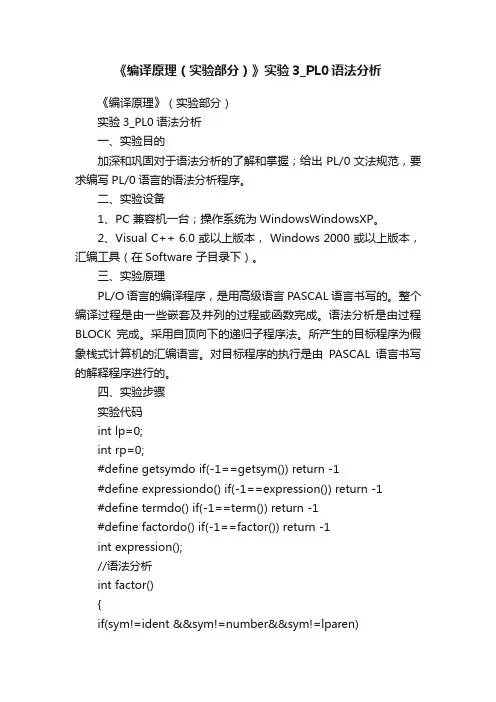
《编译原理(实验部分)》实验3_PL0语法分析《编译原理》(实验部分)实验3_PL0语法分析一、实验目的加深和巩固对于语法分析的了解和掌握;给出PL/0文法规范,要求编写PL/0语言的语法分析程序。
二、实验设备1、PC 兼容机一台;操作系统为WindowsWindowsXP。
2、Visual C++ 6.0 或以上版本, Windows 2000 或以上版本,汇编工具(在Software 子目录下)。
三、实验原理PL/O语言的编译程序,是用高级语言PASCAL语言书写的。
整个编译过程是由一些嵌套及并列的过程或函数完成。
语法分析是由过程BLOCK完成。
采用自顶向下的递归子程序法。
所产生的目标程序为假象栈式计算机的汇编语言。
对目标程序的执行是由PASCAL语言书写的解释程序进行的。
四、实验步骤实验代码int lp=0;int rp=0;#define getsymdo if(-1==getsym()) return -1#define expressiondo() if(-1==expression()) return -1#define termdo() if(-1==term()) return -1#define factordo() if(-1==factor()) return -1int expression();//语法分析int factor(){if(sym!=ident &&sym!=number&&sym!=lparen){err++;if(err==1) printf("语法错误: \n");printf("error----Factor Needs Ident or Number or Lparen\n");}if ((sym == ident) || (sym == number) || (sym == lparen)){if (sym == ident){WordAnalyse();if(getsym()==-1){return -1;}if(sym!=times&&sym!=slash&&sym!=plus&&sym!=minus &&sym!=rparen){err++;if(err==1) printf("语法错误: \n");printf("变量后没有跟上+-*\\ \n");}if(lp==0 && sym==rparen){err++;if(err==1) printf("语法错误: \n");printf("没有左括号匹配\n");}}else if (sym == number){WordAnalyse();if(getsym()==-1){return -1;}if(sym!=times&&sym!=slash&&sym!=plus&&sym!=minus &&sym!=rparen) {err++;if(err==1) printf("语法错误: \n");printf("数字后没有跟上+-*\\ \n");}if(lp==0 && sym==rparen){err++;if(err==1) printf("语法错误: \n");printf("没有左括号匹配\n");}}else if (sym == lparen){WordAnalyse();lp++;if(getsym()==-1){lp--;err++;if(err==1) printf("语法错误: \n");printf("error----Needs Rparen \n");return -1;}expressiondo();if (sym == rparen){WordAnalyse();lp--;if(getsym()==-1){return -1;}if(sym!=times&&sym!=slash&&sym!=plus&&sym!=minus) {err++;if(err==1) printf("语法错误: \n");printf("括号后没有跟上+-*\\ \n");}}else{err++;if(err==1) printf("语法错误: \n");printf("error----Needs Rparen \n");}}}return 0;}int term(){factordo();if(sym!=times&&sym!=slash&&sym!=plus&&sym!=minus&&sym!=ident&&sym!=number&&sym!=lparen&&sym!=rparen) {err++;if(err==1) printf("语法错误: \n");printf("不能识别字符\n");}while ((sym == times) || (sym == slash)){WordAnalyse();if(getsym()==-1){err++;if(err==1) printf("语法错误: \n");printf("* \\ 后缺项\n");return -1;}factordo();}return 0;}int expression(){if ((sym == plus) || (sym == minus)){//cout<<strlen(id)<<endl;< p="">if (sym==minus&&2==strlen(ID)+1)flg=1;else{flg=0;WordAnalyse();}getsymdo;termdo();}else{//WordAnalyse();termdo();}if(sym!=times&&sym!=slash&&sym!=plus&&sym!=minus &&sym!=ident&&sym!=number&&sym!=lparen&&sym!=rparen){err++;if(err==1) printf("语法错误: \n");printf("不能识别字符\n");}while ((sym == plus) || (sym == minus)){WordAnalyse();if(getsym()==-1){err++;if(err==1) printf("语法错误: \n");printf("+ - 后缺项\n");return -1;}termdo();}return 0;}int main(int argc, char* argv[]){init();err=0;ifstream fin("in.txt");ofstream fout("out.txt");ch=' ';lp=0;getsymdo;expression();if(err==0) cout<<"语法正确"<<endl;< p="">elsecout<<"语法错误,错误个数: "<<err<<=""></err< </endl;<></strlen(id)<<endl;<>。
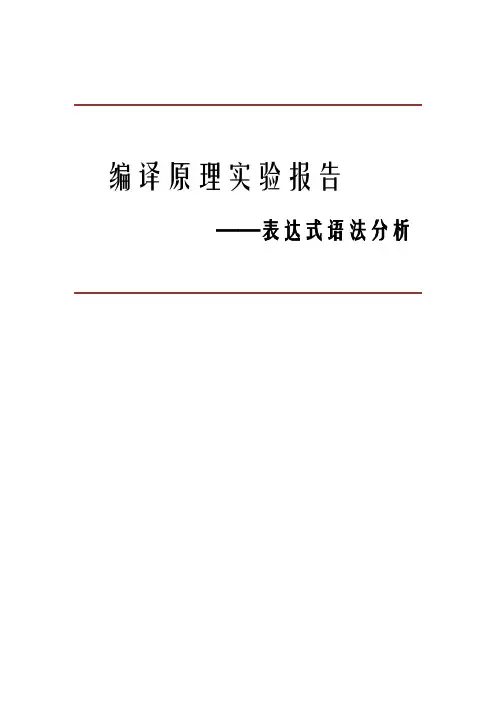
编译原理实验报告——表达式语法分析 ——表达式语法分析表达式语法分析实验报告一、实验题目设计一个简单的表达式语法分析器 (采用递归下降方法设计实现)二、实验目的1、 了解形式语言基础及其文法运算; 2、 熟悉语法分析原理及 4 种常用的语法分析方法; 其中: 四种算法为 (1)设计算术表达式的递归下降子程序分析算法 (2)设计算术表达式的 LL(1) 分析算法 (3)设计算术表达式的简单优先分析算法 (4)设计算术表达式的 SLR(1) 分析算法 3、选择上述一种方法并设计一个表达式的语法分析器。
(本实验设计的是递归下降的表达式语法分析器)三、实验内容1.设计递归下降语法分析器算法; 2.编写代码并上机调试运行通过; 3、写出试验体会及心得。
四、实验要求1、 给出算术表达式文法 2、 进行适当的文法变换 3、 选择一种语法分析的方法,并说明其原理 4、 根据原理给出相应的算法设计,说明主要的数据结构并画出算法流 程图 5、 编写代码并上机调试运行通过 6、 写出程序运行结果 7、 写出相应的文档以及代码注释 8、输入——表达式; 输出——表达式语法是否正确。
五、递归下降的表达式语法分析器设计概要1.算术表达式文法 . G(E): E T F 2.文法变换: 文法变换: G’(E): E->TE' E'->+TE'|ε T->FT' T'->*FT'|ε F->(E)|I E +T | T T* F | F i | (E)3. 递归下降子程序框图: 递归下降子程序框图:六、实验设计源程序#include <iostream.h>char inputstream[50]; int temp=0; int right; void e(); void e1(); void t(); void t1(); void f(); void main() { right=1;//存储输入句子//数组下标 //判断输出信息cout<<"请输入您要分析的字符串以#结束(^为空字符):"<<endl; cin>>inputstream; e(); if((inputstream[temp]=='#')&&right) cout<<"分析成功"<<endl; else cout<<"分析失败"<<endl; } void e() { cout<<"E->TE'"<<endl; t(); e1(); } void e1() { if(inputstream[temp]=='+') { cout<<"E'->+TE'"<<endl; temp++; t();e1(); } else if (inputstream[temp]!='#'||inputstream[temp]!=')') { cout<<"T'->^"<<endl; return ; } else right=0; } void t() { cout<<"T->FT'"<<endl; f(); t1(); } void t1() { if(inputstream[temp]=='*') { cout<<"T'->*FT'"<<endl; temp++; f(); t1(); } else if (inputstream[temp]!='#'&&inputstream[temp]!=')'&&inputstream[temp ]!='+') { cout<<"T'->^"<<endl; right=0;} } void f() { if(inputstream[temp]=='i') { cout<<"F->i"<<endl; temp++; } elseif(inputstream[temp]=='(') { cout<<"F->(E)"<<endl; temp++; e(); if(inputstream[temp]==')') { cout<<"F->(E)"<<endl; temp++; } else right=0; } else right =0; }七、运行结果八、实验思考题语法分析的任务是什么? 语法分析的任务是什么? 答:语法分析器的任务是识别和处理比单词更大的语法单位,如:程序设 计语言中的表达式、各种说明和语句乃至全部源程序,指出其中的语法错误; 必要时,可生成内部形式,便于下一阶段处理。
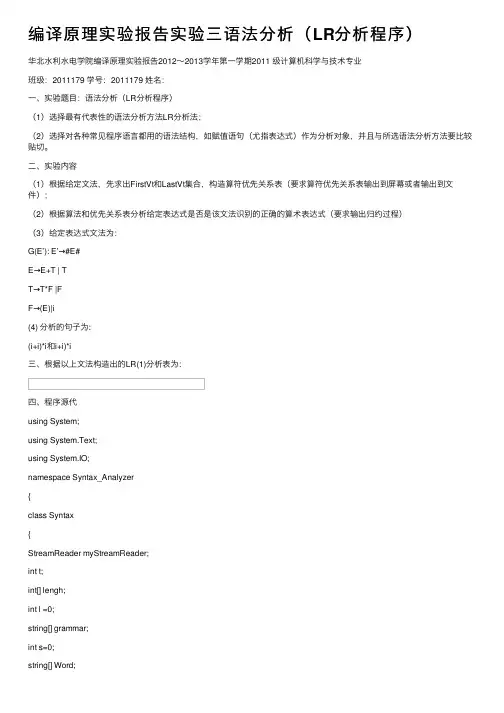
编译原理实验报告实验三语法分析(LR分析程序)华北⽔利⽔电学院编译原理实验报告2012~2013学年第⼀学期2011 级计算机科学与技术专业班级:2011179 学号:2011179 姓名:⼀、实验题⽬:语法分析(LR分析程序)(1)选择最有代表性的语法分析⽅法LR分析法;(2)选择对各种常见程序语⾔都⽤的语法结构,如赋值语句(尤指表达式)作为分析对象,并且与所选语法分析⽅法要⽐较贴切。
⼆、实验内容(1)根据给定⽂法,先求出FirstVt和LastVt集合,构造算符优先关系表(要求算符优先关系表输出到屏幕或者输出到⽂件);(2)根据算法和优先关系表分析给定表达式是否是该⽂法识别的正确的算术表达式(要求输出归约过程)(3)给定表达式⽂法为:G(E’): E’→#E#E→E+T | TT→T*F |FF→(E)|i(4) 分析的句⼦为:(i+i)*i和i+i)*i三、根据以上⽂法构造出的LR(1)分析表为:四、程序源代using System;using System.Text;using System.IO;namespace Syntax_Analyzer{class Syntax{StreamReader myStreamReader;int t;int[] lengh;int l =0;string[] grammar;int s=0;string[] Word;int w=0;int[] wordNum ;int n =0;int[,] LR;public Syntax(){lengh = new int[7];grammar=new string[7];Word=new string[100];wordNum = new int[100];LR=new int[30,30];}public void analyzer(){//读⼊grammarSyntax myTextRead=new Syntax();Console.WriteLine("-----------------------------语法分析开始---------------------------------\n"); //***************************//循环读取⽂法//***************************string strStart;strStart="grammar.txt";myTextRead.myStreamReader=new StreamReader(strStart);string strBufferStart;int uu=0;do{strBufferStart =myTextRead.myStreamReader.ReadLine();if(strBufferStart==null)break;foreach (String subString in strBufferStart.Split()){grammar[uu]=subString; //每⾏⽂法存⼊grammar[]uu++;}}while (strBufferStart!=null);myTextRead.myStreamReader.Close();//***************************//循环读取lengh//***************************strStart="lengh.txt";myTextRead.myStreamReader=new StreamReader(strStart);uu=0;do{strBufferStart =myTextRead.myStreamReader.ReadLine();if(strBufferStart==null)break;foreach (String subString in strBufferStart.Split()){lengh[uu]=Convert.ToInt32(subString); //每⾏⽂法存⼊grammar[] uu++;}}while (strBufferStart!=null);myTextRead.myStreamReader.Close();//****************************// 读⼊⽂件,进⾏语法分析////****************************string strReadFile;strReadFile="input.txt";myTextRead.myStreamReader=new StreamReader(strReadFile); string strBufferText;int wid =0;Console.WriteLine("分析读⼊程序(记号ID):\n");do{strBufferText =myTextRead.myStreamReader.ReadLine();if(strBufferText==null)break;foreach (String subString in strBufferText.Split()){if(subString!=""){int ll;if(subString!=null){ll= subString.Length; //每⼀个长度}else{break;}int a=ll+1;char[] b = new char[a];StringReader sr = new StringReader(subString); sr.Read(b, 0, ll); //把substring 读到char[]数组⾥int sort=(int)b[0];// word[i] 和wordNum[i]对应//先识别出⼀整个串,再根据开头识别是数字还是字母Word[wid]=subString;if(subString.Equals("+")){wordNum[wid]=0;}else{if(subString.Equals("*")){wordNum[wid]=1;}else{if(subString.Equals("(")){wordNum[wid]=2;}else{if(subString.Equals(")")){wordNum[wid]=3;}else{if(subString.Equals("i")){wordNum[wid]=4;}}}}}Console.Write(subString+"("+wordNum[wid]+")"+" ");wid++;}}Console.WriteLine("\n");}while (strBufferText!=null);wordNum[wid]=5;myTextRead.myStreamReader.Close();//*********************************//读⼊LR分析表////***********************************string strLR;strLR="LR-table.txt";myTextRead.myStreamReader=new StreamReader(strLR); string strBufferLR;int pp=0;do{strBufferLR =myTextRead.myStreamReader.ReadLine(); if(strBufferLR==null)break;else{int j=0;foreach (String subString in strBufferLR.Split())if(subString!=null){int lllr=Convert.ToInt16(subString);LR[pp,j]=lllr; //把⾏与列读⼊数组j++;}}}pp++;}while (strBufferLR!=null);myTextRead.myStreamReader.Close();int[] state = new int[100];string[] symbol =new string[100];state[0]=0;symbol[0]="#";int p1=0;int p2=0;Console.WriteLine("\n按⽂法规则归约顺序如下:\n"); //***************//归约算法//***************while(true){int j,k;j=state[p2];k=wordNum[p1];t=LR[j,k]; //当出现t为的时候if(t==0){//错误类型string error = "" ;if (k == 0)error = "+";if (k == 1)error = "*";elseif (k == 2)error = "(";elseif (k == 3)error = ")";elseif (k == 4)error = "i";elseerror = " 其它错误!";Console.WriteLine("\n检测结果:");Console.WriteLine("代码中存在语法错误");Console.WriteLine("错误状况:错误状态编号为"+j+" 读头下符号为"+error); break;}else{if(t==-100) //-100为达到接受状态{Console.WriteLine("\n");Console.WriteLine("\n检测结果:");Console.WriteLine("代码通过语法检测");break;}if(t<0&&t!=-100) //归约{string m=grammar[-t];Console.Write(m+" "); //输出开始符int length=lengh[-t];p2=p2-(length-1);Search mySearch=new Search();int right=mySearch.search(m);if(right==0){Console.WriteLine("\n");Console.WriteLine("代码中有语法错误");break;}int a=state[p2-1];int LRresult= LR[a,right];state[p2]=LRresult;symbol[p2]=m;}if(t>0){p2=p2+1;state[p2]=t;symbol[p2]=Convert.ToString(wordNum[p1]);p1=p1+1;}}}myTextRead.myStreamReader.Close();Console.WriteLine("-----------------------------语法分析结束---------------------------------\n"); Console.Read();}}class Search{public int search(string x){string[] mysymbol=new string[3];mysymbol[0]="E";mysymbol[1]="T";mysymbol[2]="F";int r = 0;for(int s=0;s<=2;s++){if(mysymbol[s].Equals(x))r=s+6 ;}return r;}}}五、测试结果输⼊”( i + i ) * i”字符串,分析如下图所⽰输⼊”i + i ”字符串,分析如下图所⽰六、⼩结(包括收获、⼼得体会、存在的问题及解决问题的⽅法、建议等)本次实验是LR分析法,LR分析法是⼀种有效的⾃上⽽下分析技术,在⾃左向右扫描输⼊串时就能发现其中的任何错误。

班级:学号:姓名:实验7-8 预测分析表方法一、实验目的理解预测分析表方法的实现原理。
二、实验内容提示测试数据:1.算术表达式文法E→TAA → +TA|- TA|εT→FBB →*FB |/ FB |%FB|εF→(E) |id|num给定一符合该文法的句子,如id+id*id#,运行预测分析程序,给出分析过程和每一步的分析结果。
三.实验要求程序源代码及参考图:部分代码:void analysis ( nonterminator nont, terminator term , stack stac ){string wenjian;string rece;string ch;string top_stack;cout<<"请输入要测试的文件:";cin>>wenjian;ifstream infile ( wenjian.c_str (), ios::in );if ( !infile )cout<<"不存在"<<wenjian<<endl;else{print ();stac.push ( "E" );infile>>ch;while ( ch != "\0"){top_stack = stac.inn [stac.top];if ( term.is_term ( ch ) ){if ( top_stack == "#" && ch == "#" ){//结束stac.display ();cout<<"\t\t"<<top_stack<<"\t\t"<<ch<<"\t\t本次匹配结束!"<<endl;infile>>ch;if ( ch != "\0" ){cout<<"下一条语句开始执行匹配:"<<endl;stac.push ( "E" );continue;}else{cout<<"\t\t文件语法分析完毕!\n"<<endl;break;}}else if ( term.is_term ( top_stack ) ) //终结符{if ( top_stack == ch ) {stac.display ();cout<<"\t\t"<<top_stack<<"\t\t"<<ch<<"\t\t匹配终结符:"<<ch<<endl;stac.pop ( );}else{stac.display ();cout<<"\t\t"<<top_stack<<"\t\t"<<ch<<"\t\t出错跳过该符号"<<ch<<endl;}}else if ( ( rece = find ( top_stack, ch ) ) != "\0" )//非终结符{if ( rece == empty ){//指向空stac.display ();cout<<"\t\t"<<top_stack<<"\t\t"<<ch<<"\t\t展开非终结符:"<<top_stack<<"->ε"<<endl;stac.pop ();continue;}else if ( rece == "ERROR" )//出错{if ( nont.is_follow ( stac.inn [stac.top-1], ch ) )//属于follow集error ( 1 ){stac.display ();cout<<"\t\t"<<stac.inn [--stac.top] <<"\t\t"<<ch<<"\t\t出错,弹出该栈顶元素"<<endl;}else{//不属于follow集error ( 2 )stac.display ();cout<<"\t\t"<<stac.inn [stac.top] <<"\t\t"<<ch<<"\t\t 出错,不属于follow集故须跳过符号"<<ch <<endl;infile>>ch;}continue;}else//指向正常的非终结符{if ( rece == "id" || rece == "num" ){stac.pop ( );stac.push ( rece );}else{string str2;int i = 0;while ( rece[i] != '\0' )i ++;stac.pop ();for ( int j = i - 1; j >= 0; j -- ){str2 += rece[j];stac.push ( str2 );str2 = "\0";}}stac.display ();cout<<"\t\t"<<top_stack<<"\t\t"<<ch<<"\t\t展开非终结符:"<<top_stack<<"->"<<rece<<endl;continue;}}}else {stac.display ();cout<<"\t\t"<<top_stack<<"\t\t"<<ch<<"\t\t出错,跳过,无法识别该标识符"<<ch<<endl;}infile>>ch;}}infile.close ();}输出形式参考下图:四、实验总结通过实验,我对LL1()的算法有了初步的了解,基本能够编出代码,虽然有的地方处理的不是很好,我想通过后期的改正能够把程序改的完美。

实验3 语义分析实验报告一、实验目的二、通过上机实习, 加深对语法制导翻译原理的理解, 掌握将语法分析所识别的语法成分变换为中间代码的语义翻译方法。
三、实验要求四、采用递归下降语法制导翻译法, 对算术表达式、赋值语句进行语义分析并生成四元式序列。
五、算法思想1.设置语义过程。
(1)emit(char *result,char *ag1,char *op,char *ag2)该函数的功能是生成一个三地址语句送到四元式表中。
四元式表的结构如下:struct{ char result[8];char ag1[8];char op[8];char ag2[8];}quad[20];(2) char *newtemp()该函数回送一个新的临时变量名, 临时变量名产生的顺序为T1, T2, …char *newtemp(void){ char *p;char m[8];p=(char *)malloc(8);k++;itoa(k,m,10);strcpy(p+1,m);p[0]=’t’;return(p);}六、 2.函数lrparser 在原来语法分析的基础上插入相应的语义动作: 将输入串翻译成四元式序列。
在实验中我们只对表达式、赋值语句进行翻译。
源程序代码:#include<stdio.h>#include<string.h>#include<iostream.h>#include<stdlib.h>struct{char result[12];char ag1[12];char op[12];char ag2[12];}quad;char prog[80],token[12];char ch;int syn,p,m=0,n,sum=0,kk; //p是缓冲区prog的指针, m是token的指针char *rwtab[6]={"begin","if","then","while","do","end"};void scaner();char *factor(void);char *term(void);char *expression(void);int yucu();void emit(char *result,char *ag1,char *op,char *ag2);char *newtemp();int statement();int k=0;void emit(char *result,char *ag1,char *op,char *ag2){strcpy(quad.result,result);strcpy(quad.ag1,ag1);strcpy(quad.op,op);strcpy(quad.ag2,ag2);cout<<quad.result<<"="<<quad.ag1<<quad.op<<quad.ag2<<endl;}char *newtemp(){char *p;char m[12];p=(char *)malloc(12);k++;itoa(k,m,10);strcpy(p+1,m);p[0]='t';return (p);}void scaner(){for(n=0;n<8;n++) token[n]=NULL;ch=prog[p++];while(ch==' '){ch=prog[p];p++;}if((ch>='a'&&ch<='z')||(ch>='A'&&ch<='Z')){m=0;while((ch>='0'&&ch<='9')||(ch>='a'&&ch<='z')||(ch>='A'&&ch<='Z')){token[m++]=ch;ch=prog[p++];}token[m++]='\0';p--;syn=10;for(n=0;n<6;n++)if(strcmp(token,rwtab[n])==0){syn=n+1;break;}}else if((ch>='0'&&ch<='9')){{sum=0;while((ch>='0'&&ch<='9')){sum=sum*10+ch-'0';ch=prog[p++];}}p--;syn=11;if(sum>32767)syn=-1;}else switch(ch){case'<':m=0;token[m++]=ch;ch=prog[p++];if(ch=='>'){syn=21;token[m++]=ch;}else if(ch=='='){syn=22;token[m++]=ch;}else{syn=23;p--;}break;case'>':m=0;token[m++]=ch;ch=prog[p++];if(ch=='='){syn=24;token[m++]=ch;}else{syn=20;p--;}break;case':':m=0;token[m++]=ch;ch=prog[p++];if(ch=='='){syn=18;token[m++]=ch;}else{syn=17;p--;}break;case'*':syn=13;token[0]=ch;break; case'/':syn=14;token[0]=ch;break; case'+':syn=15;token[0]=ch;break; case'-':syn=16;token[0]=ch;break; case'=':syn=25;token[0]=ch;break; case';':syn=26;token[0]=ch;break; case'(':syn=27;token[0]=ch;break; case')':syn=28;token[0]=ch;break; case'#':syn=0;token[0]=ch;break; default: syn=-1;break;}}int lrparser(){//cout<<"调用lrparser"<<endl;int schain=0;kk=0;if(syn==1){scaner();schain=yucu();if(syn==6){scaner();if(syn==0 && (kk==0))cout<<"success!"<<endl;}else{if(kk!=1)cout<<"缺end!"<<endl;kk=1;}}else{cout<<"缺begin!"<<endl;kk=1;}return(schain);}int yucu(){// cout<<"调用yucu"<<endl;int schain=0;schain=statement();while(syn==26){scaner();schain=statement();}return(schain);}int statement(){//cout<<"调用statement"<<endl;char *eplace,*tt;eplace=(char *)malloc(12);tt=(char *)malloc(12);int schain=0;switch(syn){case 10:strcpy(tt,token);scaner();if(syn==18){scaner();strcpy(eplace,expression());emit(tt,eplace,"","");schain=0;}else{cout<<"缺少赋值符!"<<endl;kk=1;}return(schain);break;}return(schain);}char *expression(void){char *tp,*ep2,*eplace,*tt;tp=(char *)malloc(12);ep2=(char *)malloc(12);eplace=(char *)malloc(12);tt =(char *)malloc(12);strcpy(eplace,term ()); //调用term分析产生表达式计算的第一项eplacewhile((syn==15)||(syn==16)){if(syn==15)strcpy(tt,"+");else strcpy(tt,"-");scaner();strcpy(ep2,term()); //调用term分析产生表达式计算的第二项ep2strcpy(tp,newtemp()); //调用newtemp产生临时变量tp存储计算结果emit(tp,eplace,tt,ep2); //生成四元式送入四元式表strcpy(eplace,tp);}return(eplace);}char *term(void){// cout<<"调用term"<<endl;char *tp,*ep2,*eplace,*tt;tp=(char *)malloc(12);ep2=(char *)malloc(12);eplace=(char *)malloc(12);tt=(char *)malloc(12);strcpy(eplace,factor());while((syn==13)||(syn==14)){if(syn==13)strcpy(tt,"*");else strcpy(tt,"/");scaner();strcpy(ep2,factor()); //调用factor分析产生表达式计算的第二项ep2strcpy(tp,newtemp()); //调用newtemp产生临时变量tp存储计算结果emit(tp,eplace,tt,ep2); //生成四元式送入四元式表strcpy(eplace,tp);}return(eplace);}char *factor(void){char *fplace;fplace=(char *)malloc(12);strcpy(fplace,"");if(syn==10){strcpy(fplace,token); //将标识符token的值赋给fplacescaner();}else if(syn==11){itoa(sum,fplace,10);scaner();}else if(syn==27){scaner();fplace=expression(); //调用expression分析返回表达式的值if(syn==28)scaner();else{cout<<"缺)错误!"<<endl;kk=1;}}else{cout<<"缺(错误!"<<endl;kk=1;}return(fplace);}void main(){p=0;cout<<"**********语义分析程序**********"<<endl;cout<<"Please input string:"<<endl;do{cin.get(ch);prog[p++]=ch;}while(ch!='#');p=0;scaner();lrparser();}七、结果验证1、给定源程序begin a:=2+3*4; x:=(a+b)/c end#输出结果2、源程序begin a:=9; x:=2*3-1; b:=(a+x)/2 end#输出结果八、收获(体会)与建议通过此次实验, 让我了解到如何设计、编制并调试语义分析程序, 加深了对语法制导翻译原理的理解, 掌握了将语法分析所识别的语法成分变换为中间代码的语义翻译方法。


《编译原理》实验报告班级:计C104姓名:李云霄学号:108490实验一词法分析程序实现一、实验目的与要求通过编写和调试一个词法分析程序,掌握在对程序设计语言的源程序进行扫描的过程中,将字符形式的源程序流转化为一个由各类单词符号组成的流的词法分析方法。
二、实验内容选取无符号数的算术四则运算中的各类单词为识别对象,要求将其中的各个单词识别出来。
输入:由无符号数和+,-,*,/, ( , ) 构成的算术表达式,如1.5E+2-100。
输出:对识别出的每一单词均单行输出其类别码(无符号数的值暂不要求计算)。
三、实现方法与环境1、首先设计识别各类单词的状态转换图。
描述无符号常数的确定、最小化状态转换图如图1所示。
其中编号0,1,2,…,6代表非终结符号<无符号数>、<余留无符号数>、<十进小数>、<小数部分>、<指数部分>、<整指数>及<余留整指数>, 1,2和6为终态,分别代表整数、小数和科学计数的识别结束状态。
图1 文法G[<无符号数>]的状态转换图其中编号0,1,2,…,6代表非终结符号<无符号数>、<余留无符号数>、<十进小数>、<小数部分>、<指数部分>、<整指数>及<余留整指数>, 1,2和6为终态,分别代表整数、小数和科学计数的识别结束状态。
在一个程序设计语言中,一般都含有若干类单词符号,为此可首先为每类单词建立一张状态转换图,然后将这些状态转换图合并成一张统一的状态图,即得到了一个有限自动机,再进行必要的确定化和状态数最小化处理,最后据此构造词法分析程序。
四则运算算术符号的识别很简单,直接在状态图的0状态分别引出相应标记的矢根据描述语言中各类单词的文法状态转换图或状态矩阵,利用某种语言(C语言或JAVA语言)直接编写词法分析程序。
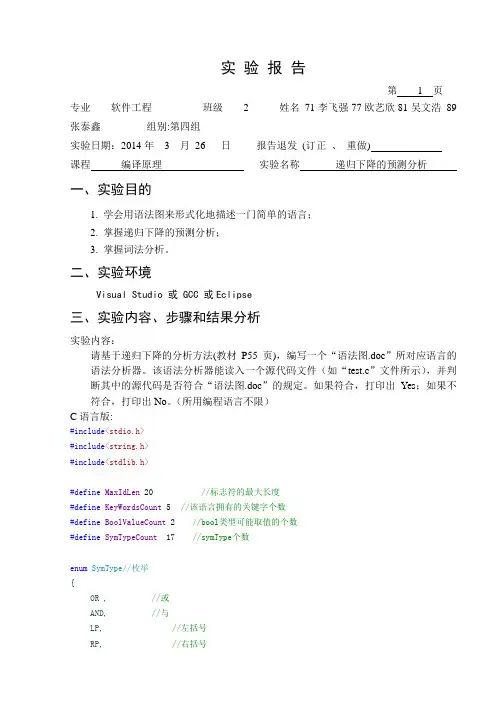
实验报告第 1 页专业____软件工程________ 班级____2_____ 姓名_71李飞强77欧艺欣81吴文浩89张泰鑫__ 组别:第四组实验日期:2014年 3 月26 日报告退发(订正、重做)课程编译原理实验名称递归下降的预测分析一、实验目的1. 学会用语法图来形式化地描述一门简单的语言;2. 掌握递归下降的预测分析;3. 掌握词法分析。
二、实验环境Visual Studio 或 GCC 或Eclipse三、实验内容、步骤和结果分析实验内容:请基于递归下降的分析方法(教材P55页),编写一个“语法图.doc”所对应语言的语法分析器。
该语法分析器能读入一个源代码文件(如“test.c”文件所示),并判断其中的源代码是否符合“语法图.doc”的规定。
如果符合,打印出Yes;如果不符合,打印出No。
(所用编程语言不限)C语言版:#include<stdio.h>#include<string.h>#include<stdlib.h>#define MaxIdLen 20 //标志符的最大长度#define KeyWordsCount 5 //该语言拥有的关键字个数#define BoolValueCount 2 //bool类型可能取值的个数#define SymTypeCount 17 //symType个数enum SymType//枚举{OR , //或AND, //与LP, //左括号RP, //右括号ID, //标志符ASSIGN, //赋值LB, //左大括号RB, //右大括号COMMA, //逗号SEMICOLON, //分号UNDEFINED, //未定义BOOLVALUE, //bool类型的值IF, //ifELSE, //elseWHILE, //whilePRINTF, //printfBOOL, //bool};enum boolValue{TRUE,FALSE,};//关键字static char * keywords[KeyWordsCount] = { "if","else","while","printf","bool",};//关键字对应类别static int keyType[KeyWordsCount] = { IF,ELSE,WHILE,PRINTF,BOOL,};static char * boolvalue[BoolValueCount]={"true","false",};static int boolValueType[BoolValueCount]={TRUE,FALSE,};char ch=' '; //当前字符char id[MaxIdLen+1]; //当前符号串int token; //当前记号(的类型)int value; //当前记号的值FILE * fp; //用来打开要识别的源代码文件int lineNum=1; //要识别的代码行数bool isPass = false ; //判断识别的代码是否全部合法void getToken();void program();void program();void statement();void definition();void term();void factor();void expression();void match(int t);void main(){fopen_s(&fp,"D:\\test.c","r");getToken();program();if(isPass)printf("Y\n");else printf("N\n");fclose(fp);}/****************************************lexical*****************************************/int getKeyWord(char * str){for(int i=0;i<KeyWordsCount;i++)if(strcmp(str,keywords[i])==0)return keyType[i];return UNDEFINED;}int getBoolValue(char* str){for(int i=0;i<BoolValueCount;i++)if(strcmp(str,boolvalue[i])==0){value = boolValueType[i];return BOOLVALUE;}return UNDEFINED;}bool isLetter(char ch){return (ch>='A'&&ch<='Z')||(ch>='a'&&ch<='z'); }bool isDigit(char ch){return ch>='0'&&ch<='9';}void nextChar(){ch = fgetc(fp);}void getToken(){while(ch==' '||ch=='\t'||ch=='\r'||ch=='\n'){if(ch == '\n')lineNum++;nextChar();}if(isLetter(ch)){int index=0;id[index++] = ch;nextChar();while(isLetter(ch) || isDigit(ch)){if(index<MaxIdLen){id[index++] = ch;nextChar();}else{//cout<<"identifier is too long."<<endl;//exit(1);}}id[index]='\0';token = getKeyWord(id);if(token == UNDEFINED)token = getBoolValue(id);if(token == UNDEFINED){token = ID;}}else if(ch == '='){token = ASSIGN;nextChar();}else if(ch=='|'){nextChar();if(ch=='|'){token=OR;nextChar();}elseexit(1);}else if(ch=='&'){nextChar();if(ch=='&'){token=AND;nextChar();}elseexit(1);}else if(ch == ';'){token = SEMICOLON;nextChar();}else if(ch == '('){token = LP;nextChar();}else if(ch == ')'){token = RP;nextChar();}else if(ch == ','){token = COMMA;nextChar();}else if(ch == '{'){token = LB;nextChar();}else if(ch == '}'){token = RB;nextChar();}else if(ch == EOF){printf(" EOF!\n");isPass = true;}else{printf("第%d行不能识别的符号!\n",lineNum );exit(1);}}/****************************************grammar*****************************************/void match(int t){if(t == token){getToken();}else{printf("大概在第%d行错误\n",lineNum);exit(1);}}void expression(){term();while(token == OR){match(OR);term();}}void factor(){if(token == BOOLVALUE && value == TRUE)match(BOOLVALUE);else if(token == BOOLVALUE && value == FALSE) match(BOOLVALUE);else if(token == LP){match(LP);expression();match(RP);}else if(token == ID)match(ID);}void term(){factor();while(token == AND){match(AND);factor();}}void definition(){do{match(BOOL);match(ID);match(ASSIGN);expression();match(SEMICOLON);}while(token == BOOL);}void statement(){if(token == IF){match(IF);match(LP);expression();match(RP);statement();if(token == ELSE){match(ELSE);statement();}}else if(token == PRINTF){match(PRINTF);match(LP);expression();while(token == COMMA){match(COMMA);expression();}match(RP);match(SEMICOLON);}else if(token == WHILE){match(WHILE);match(LP);expression();match(RP);statement();}else if(token == LB){match(LB);do{statement();}while(token != RB);match(RB);}else if(token == ID){match(ID);match(ASSIGN);expression();match(SEMICOLON);}else if(token == SEMICOLON){match(SEMICOLON);}}void program(){definition();statement();}Java版:(吴文浩)Java版的关键代码:// 由语法分析带动翻译public void parse(String src) {this.lexer = new GrammarLexer(src);lookahead = lexer.getToken();program();}private void match(TokenType type) {// 如果记号lookahead的类型是type,则取下一个记号System.out.println("------------>" + type);if (lookahead.tokenType.equals(type)) {lookahead = lexer.getToken();} else {error("NO");// 否则报错}}private void error(String str) {// out.println(str);System.out.println(str);System.exit(-1);}/*** program:程序 definition----->statement-------->*/public void program() {definition();//定义statement();// 声明}// definition:定义/*** bool-->id-->=-->expression-->;*/public void definition() {do {match(TokenType.BOOLEAN);match(TokenType.ID);match(TokenType.EQUAL);expression();match(TokenType.SEMICOLON);// 匹配分号} while (lookahead.isBoolean());}// statement:声明public void statement() {if(lookahead.isIf()) {// -->if-->(-->expression-->)-->statement--->match(TokenType.IF);match(TokenType.LeftP);expression();match(TokenType.RightP);statement();if(lookahead.isElse()) {//缺陷:如果用全部代码测试时,程序走到这里停止了,while循环后的语句将不能执行!match(TokenType.ELSE);statement();} else {}} else if (lookahead.isWhile()) {match(TokenType.WHILE);match(TokenType.LeftP);expression();match(TokenType.RightP);statement();} else if (lookahead.isPrint()) {match(TokenType.PRINT);match(TokenType.LeftP);expression();while (lookahead.isComma()) {match(MA);expression();}match(TokenType.RightP);match(TokenType.SEMICOLON);} else if (lookahead.isSemicolon()) {// ;match(TokenType.SEMICOLON);} else if (lookahead.isLeftBrace()) {match(TokenType.LeftBrace);statement();while(!lookahead.isRightBrace() || lookahead.isId() ){//必须加入lookahead.isId()否则a = false;运行不出来(语法图缺陷吧!)statement();}match(TokenType.RightBrace);} else if (lookahead.isId()) {// id = expression;// System.out.println("++++++++++++++++++++");match(TokenType.ID);match(TokenType.EQUAL);expression();match(TokenType.SEMICOLON);} else {}}/***expression:式子-------->term()----(---->||------->term()---->);*/private void expression() {term();while (lookahead.isOr()) {// 如果是||就继续循环处理match(TokenType.OR);term();}}/***term:项 Factor(); While(match(‘&&’)){ Factor(); }*/private void term() {factor();while (lookahead.isAnd()) {// 判断是&&就继续进行match(TokenType.AND);factor();}}/*** --->(------>expression--------->)--------->* ---->true---->* ---->false---->* ---->id------>*/private void factor() {if (lookahead.isTrue()) {match(TokenType.TRUE);} else if (lookahead.isLeftP()) {match(TokenType.LeftP);expression();match(TokenType.RightP);} else if (lookahead.isFalse()) {match(TokenType.FALSE);} else if (lookahead.isId()) {match(TokenType.ID);} else{}}/*** 获取下一个Token*/public Token getToken() {int value = 0;char cur;while (true) {if (index >= src.length())return Token.EOF;else {// 取下一字符cur = next();// 如果下一个字符是空白,继续读取字符if (this.isBlank(cur))continue;else if (this.isAlpha(cur)) {// 字符缓冲区StringBuilder buffer = new StringBuilder();buffer.append(cur);while (isAlpha((char) peek())) {buffer.append(next());}if(buffer.toString().equals(KeyWord.BOOLEAN)) {return new Token(TokenType.BOOLEAN, buffer.toString());} else if (buffer.toString().equals(KeyWord.FALSE)) {return new Token(TokenType.FALSE, buffer.toString());} else if (buffer.toString().equals(KeyWord.TRUE)) {return new Token(TokenType.TRUE, buffer.toString());} else if(buffer.toString().equals(KeyWord.IF)) {return new Token(TokenType.IF, buffer.toString());} else if (buffer.toString().equals(KeyWord.WHILE)) {return new Token(TokenType.WHILE, buffer.toString());} else if (buffer.toString().equals(KeyWord.PRINT)) {return new Token(TokenType.PRINT, buffer.toString());} else {return new Token(TokenType.ID, buffer.toString());}} else if (cur == ',') {return MA;} else if (cur == '(') {return Token.LeftP;} else if (cur == ')') {return Token.RightP;} else if (cur == '|' && next() == '|') {return Token.OR;// 或者} else if (cur == '&' && next() == '&') {return Token.AND;// 且} else if (cur == '=') {return Token.EQUAL;} else if (cur == ';') {return Token.SEMICOLON;// 分号} else if (cur == '{') {// 左大括号return Token.LeftBrace;} else if (cur == '}') {return Token.RightBrace;} else if (cur == '\n') {line++;} else {this.error();}}}}运行这个测试代码的截图:String src = "boolean a = true;boolean b = false;boolean c = (a && b);if( a || b) print(a,b);else print(c);";运行这个测试代码的截图:String src = "boolean a = true; while(a && (b||c)){print(a,b,c);a = false;}";四、讨论(说明实验过程中遇到的问题及解决办法;未解决/需进一步研讨的问题或建议新实验方法等)在text.c中先是声明bool类型,然后是if语句,最后是while语句。

编译原理实验教程课程设计背景编译原理是计算机科学专业的一门重要课程,它研究如何将高级语言翻译成低级语言,以便计算机执行。
编译器是实现这一过程的关键工具。
然而,对于很多学生来说,编译原理的理论知识学习起来比较抽象,难以掌握。
因此,本文旨在为编译原理的学习提供一些实验教程的设计思路。
实验一:词法分析器词法分析器是编译器的第一个模块,它的作用是将输入的字符流转化为一个个单词符号。
本实验的目的是设计并实现一个简单的词法分析器,实现以下功能:1.识别输入的程序中所包含的各个单词符号。
2.输出所有单词符号及其对应的单词类型。
3.当遇到不合法单词符号时,给出相应的错误提示。
具体实现可以采用有限自动机的思想,使用正则表达式或者手写代码,实现对于不同的单词类型的识别,并对于不合法单词进行识别和报错处理。
实验二:语法分析器语法分析器是编译器的第二个模块,它的作用是将词法分析器输出的单词序列转换成语法树或者语法分析表,以便后续进行语义分析和目标代码生成。
本实验的目的是设计并实现一个简单的语法分析器,实现以下功能:1.识别输入的程序是否符合所设计的文法规则。
2.输出语法树或语法分析表。
具体实现可以采用自上而下的递归下降分析法或自下而上的移进-规约分析法,实现对于不同的句型的识别,并生成语法树或语法分析表。
实验三:语义分析器语义分析器是编译器的第三个模块,它的作用是对语法分析器输出的语法树或语法分析表进行语义分析,并生成中间代码。
本实验的目的是设计并实现一个简单的语义分析器,实现以下功能:1.对语法树或语法分析表进行遍历,识别语法错误和语义错误,给出相应的错误提示。
2.生成中间代码。
具体实现可以采用语义规则和符号表的检查方式,识别语法错误和语义错误,并在生成中间代码时,根据中间代码语言的规则进行实现。
实验四:目标代码生成器目标代码生成器是编译器的第四个模块,它的作用是将中间代码转换成机器语言,以便计算机执行。
本实验的目的是设计并实现一个简单的目标代码生成器,实现以下功能:1.将中间代码转换成机器语言。
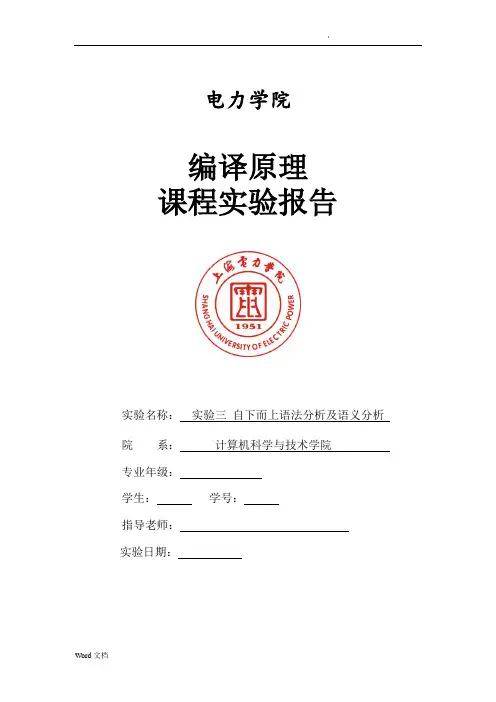
电力学院编译原理课程实验报告实验名称:实验三自下而上语法分析及语义分析院系:计算机科学与技术学院专业年级:学生:学号:指导老师:实验日期:实验三自上而下的语法分析一、实验目的:通过本实验掌握LR分析器的构造过程,并根据语法制导翻译,掌握属性文法的自下而上计算的过程。
二、实验学时:4学时。
三、实验容根据给出的简单表达式的语法构成规则(见五),编制LR分析程序,要求能对用给定的语法规则书写的源程序进行语法分析和语义分析。
对于正确的表达式,给出表达式的值。
对于错误的表达式,给出出错位置。
四、实验方法采用LR分析法。
首先给出S-属性文法的定义(为简便起见,每个文法符号只设置一个综合属性,即该文法符号所代表的表达式的值。
属性文法的定义可参照书137页表6.1),并将其改造成用LR分析实现时的语义分析动作(可参照书145页表6.5)。
接下来给出LR分析表。
然后程序的具体实现:● LR分析表可用二维数组(或其他)实现。
●添加一个val栈作为语义分析实现的工具。
编写总控程序,实现语法分析和语义分析的过程。
注:对于整数的识别可以借助实验1。
五、文法定义简单的表达式文法如下:(1)E->E+T(2)E->E-T(3)E->T(4)T->T*F(5)T->T/F(6)T->F(7)F->(E)(8)F->i五、处理程序例和处理结果例示例1:20133191*(20133191+3191)+ 3191#六、源代码【cifa.h】//cifa.h#include<string>using namespace std;//单词结构定义struct WordType{int code;string pro;};//函数声明WordType get_w();void getch();void getBC();bool isLetter();bool isDigit();void retract();int Reserve(string str);string concat(string str);【Table.action.h】//table_action.hclass Table_action{int row_num,line_num;int lineName[8];string tableData[16][8];public:Table_action(){row_num=16;line_num=8;lineName[0]=30;lineName[1]=7;lineName[2]=13;lineName[3]=8;lineName[4]=14;lineName[5]=1;lineName[6]=2;lineName[7]=15;lineName[8]=0;for(int m=0;m<row_num;m++)for(int n=0;n<line_num;n++)tableData[m][n]="";tableData[0][0]="S5";tableData[0][5]="S4";tableData[1][1]="S6";tableData[1][2]="S12";tableData[1][7]="acc";tableData[2][1]="R3";tableData[2][2]="R3";tableData[2][3]="S7";tableData[2][4]="S13";tableData[2][6]="R3";tableData[2][7]="R3";tableData[3][1]="R6";tableData[3][3]="R6"; tableData[3][4]="R6"; tableData[3][6]="R6"; tableData[3][7]="R6"; tableData[4][0]="S5"; tableData[4][5]="S4"; tableData[5][1]="R8"; tableData[5][2]="R8"; tableData[5][3]="R8"; tableData[5][4]="R8"; tableData[5][6]="R8"; tableData[5][7]="R8"; tableData[6][0]="S5"; tableData[6][5]="S4"; tableData[7][0]="S5"; tableData[7][5]="S4"; tableData[8][1]="S6"; tableData[8][2]="S12"; tableData[8][6]="S11"; tableData[9][1]="R1"; tableData[9][2]="R1"; tableData[9][3]="S7"; tableData[9][4]="S13"; tableData[9][6]="R1"; tableData[9][7]="R1"; tableData[10][1]="R4"; tableData[10][2]="R4"; tableData[10][3]="R4"; tableData[10][4]="R4"; tableData[10][6]="R4"; tableData[10][7]="R4"; tableData[11][1]="R7"; tableData[11][2]="R7"; tableData[11][3]="R7"; tableData[11][4]="R7"; tableData[11][6]="R7"; tableData[11][7]="R7"; tableData[12][0]="S5"; tableData[12][5]="S4"; tableData[13][0]="S5"; tableData[13][5]="S4"; tableData[14][1]="R2"; tableData[14][2]="R2";tableData[14][4]="S13";tableData[14][6]="R2";tableData[14][7]="R2";tableData[15][1]="R5";tableData[15][2]="R5";tableData[15][3]="R5";tableData[15][4]="R5";tableData[15][5]="R5";tableData[15][6]="R5";tableData[15][7]="R5";}string getCell(int rowN,int lineN){int row=rowN;int line=getLineNumber(lineN);if(row>=0&&row<row_num&&line>=0&&line<=line_num) return tableData[row][line];elsereturn"";}int getLineNumber(int lineN){for(int i=0;i<line_num;i++)if(lineName[i]==lineN)return i;return -1;}};【Table_go.h】//table_go.hclass Table_go{int row_num,line_num;//行数、列数string lineName[3];int tableData[16][3];public:Table_go(){row_num=16;line_num=3;lineName[0]="E";lineName[1]="T";lineName[2]="F";for(int m=0;m<row_num;m++)for(int n=0;n<line_num;n++)tableData[m][n]=0;tableData[0][0]=1;tableData[0][1]=2;tableData[0][2]=3;tableData[4][0]=8;tableData[4][1]=2;tableData[4][2]=3;tableData[6][1]=9;tableData[6][2]=3;tableData[7][2]=10;tableData[12][1]=14;tableData[12][2]=3;tableData[13][2]=15;}int getCell(int rowN,string lineNa){int row=rowN;int line=getLineNumber(lineNa);if(row>=0&&row<row_num&&line<=line_num) return tableData[row][line];elsereturn -1;}int getLineNumber(string lineNa){for(int i=0;i<line_num;i++)if(lineName[i]==lineNa)return i;return -1;}};【Stack_num.h】class Stack_num{int i; //栈顶标记int *data; //栈结构public:Stack_num() //构造函数{data=new int[100];i=-1;}int push(int m) //进栈操作{i++;data[i]=m;return i;}int pop() //出栈操作{i--;return data[i+1];}int getTop() //返回栈顶{return data[i];}~Stack_num() //析构函数{delete []data;}int topNumber(){return i;}void outStack(){for(int m=0;m<=i;m++)cout<<data[m];}};【Stack_str.h】class Stack_str{int i; //栈顶标记string *data; //栈结构public:Stack_str() //构造函数{data=new string[50];i=-1;}int push(string m) //进栈操作{i++;data[i]=m;return i;}int pop() //出栈操作{data[i]="";i--;return i;}string getTop() //返回栈顶{return data[i];}~Stack_str() //析构函数{delete []data;}int topNumber(){return i;}void outStack(){for(int m=0;m<=i;m++)cout<<data[m];}};【cifa.cpp】//cifa.cpp#include<iostream>#include<string>#include"cifa.h"using namespace std;//关键字表和对应的编码string codestring[10]={"main","int","if","then","else","return","void","cout","endl"}; int codebook[10]={26,21,22,23,24,25,27,28,29};//全局变量char ch;int flag=0;/*//主函数int main(){WordType word;cout<<"请输入源程序序列:";word=get_w();while(word.pro!="#")//#为自己设置的结束标志{cout<<"("<<word.code<<","<<"“"<<word.pro<<"”"<<")"<<endl;word=get_w();};return 0;}*/WordType get_w(){string str="";int code;WordType wordtmp;getch();//读一个字符getBC();//去掉空白符if(isLetter()){ //以字母开头while(isLetter()||isDigit()){str=concat(str);getch();}retract();code=Reserve(str);if(code==-1){wordtmp.code=0;wordtmp.pro=str;}//不是关键字else{wordtmp.code=code;wordtmp.pro=str;}//是关键字}else if(isDigit()){ //以数字开头while(isDigit()){str=concat(str);getch();}retract();wordtmp.code=30;wordtmp.pro=str;}else if(ch=='(') {wordtmp.code=1;wordtmp.pro="(";}else if(ch==')') {wordtmp.code=2;wordtmp.pro=")";}else if(ch=='{') {wordtmp.code=3;wordtmp.pro="{";}else if(ch=='}') {wordtmp.code=4;wordtmp.pro="}";}else if(ch==';') {wordtmp.code=5;wordtmp.pro=";";}else if(ch=='=') {wordtmp.code=6;wordtmp.pro="=";}else if(ch=='+') {wordtmp.code=7;wordtmp.pro="+";}else if(ch=='*') {wordtmp.code=8;wordtmp.pro="*";}else if(ch=='>') {wordtmp.code=9;wordtmp.pro=">";}else if(ch=='<') {wordtmp.code=10;wordtmp.pro="<";}else if(ch==',') {wordtmp.code=11;wordtmp.pro=",";}else if(ch=='\'') {wordtmp.code=12;wordtmp.pro="\'";}else if(ch=='-') {wordtmp.code=13;wordtmp.pro="-";}else if(ch=='/') {wordtmp.code=14;wordtmp.pro="/";}else if(ch=='#') {wordtmp.code=15;wordtmp.pro="#";}else if(ch=='|') {wordtmp.code=16;wordtmp.pro="|";}else {wordtmp.code=100;wordtmp.pro=ch;} return wordtmp;}void getch(){if(flag==0) //没有回退的字符ch=getchar();else //有回退字符,用回退字符,并设置标志flag=0;}void getBC(){while(ch==' '||ch=='\t'||ch=='\n')ch=getchar();}bool isLetter(){if(ch>='a'&&ch<='z'||ch>='A'&&ch<='Z')return true;elsereturn false;}bool isDigit(){if(ch>='0'&&ch<='9')return true;elsereturn false;}string concat(string str){return str+ch;}void retract(){flag=1;}int Reserve(string str){int i;for(i=0;i<=8;i++){if(codestring[i]==str) //是某个关键字,返回对应的编码return codebook[i];}if(i==9) //不是关键字return -1;}【LR.cpp】#include<iostream>#include<string>#include<cstdlib>#include"cifa.h"#include"stack_num.h"#include"stack_str.h"#include"table_action.h"#include"table_go.h"using namespace std;void process(){int stepNum=1;int topStat;Stack_num statusSTK; //状态栈Stack_str symbolSTK; //符号栈Stack_num valueSTK; //值栈WordType word;Table_action actionTAB; //行为表Table_go goTAB; //转向表cout<<"请输入源程序,以#结束:";word=get_w();//总控程序初始化操作symbolSTK.push("#");statusSTK.push(0);valueSTK.push(0);cout<<"步骤\t状态栈\t符号栈\t值栈\t当前词\t动作\t转向"<<endl;//分析while(1){topStat=statusSTK.getTop(); //当前状态栈顶string act=actionTAB.getCell(topStat,word.code);//根据状态栈顶和当前单词查到的动作//输出cout<<stepNum++<<"\t";statusSTK.outStack(); cout<<"\t";symbolSTK.outStack(); cout<<"\t";valueSTK.outStack(); cout<<"\t";cout<<word.pro<<"\t";//行为为“acc”,且当前处理的单词为#,且状态栈里就两个状态//说明正常分析结束if(act=="acc"&&word.pro=="#"&&statusSTK.topNumber()==1){cout<<act<<endl;cout<<"分析成功!"<<endl;cout<<"结果为:"<<valueSTK.getTop()<<endl;return;}//读到act表里标记为错误的单元格else if(act==""){cout<<endl<<"不是文法的句子!"<<endl;cout<<"错误的位置为单词"<<word.pro<<"附近。
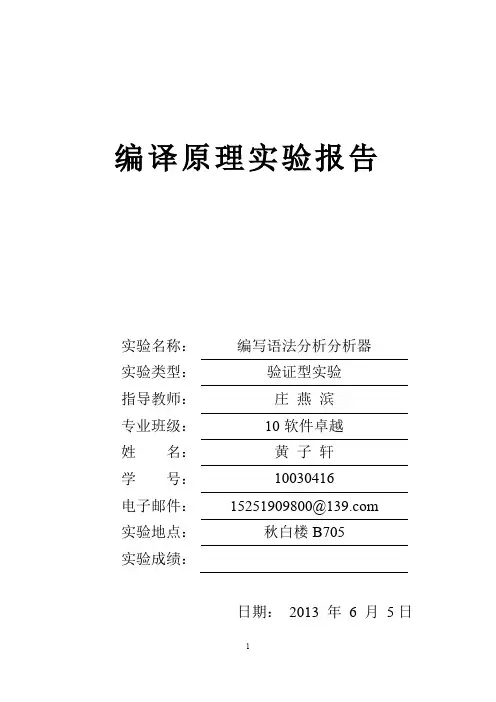
《编译原理》实验教学大纲一、实验目的和任务编译原理是计算机科学与技术专业的一门重要课程,它主要研究的是将高级语言程序翻译成机器语言程序的方法和技术。
通过本实验课程的学习,旨在使学生掌握编译原理的基本原理和方法,培养学生对编译器结构与构造技术的专门知识和技能,为学生今后进行编译器设计与实现打下基础。
二、实验设备和工具1.计算机和相关硬件设备2. 编程语言的开发环境,如C/C++或Java三、实验内容1.实验一:词法分析器设计与实现a)实验目的:学习词法分析器的原理和设计方法,掌握正则表达式、DFA和NFA的转换方法。
b)实验任务:i.设计并实现一个词法分析器的原型,能够正确地识别出给定的程序中的词法单元。
ii. 使用给定的正则表达式设计并实现识别给定程序中的关键字、标识符、常量等的词法分析器。
2.实验二:语法分析器设计与实现a)实验目的:学习语法分析器的原理和设计方法,掌握上下文无关文法和LR分析表的构造方法。
b)实验任务:i.学习并理解上下文无关文法和LR分析表的构造方法。
ii. 设计并实现一个简单的递归下降语法分析器。
3.实验三:语义分析器设计与实现a)实验目的:学习语义分析器的原理和设计方法,掌握语义动作的定义和处理方法。
b)实验任务:i.学习并理解语义分析器的原理和设计方法。
ii. 设计并实现一个简单的语义分析器,能够对给定的程序进行语义分析和语义动作的处理。
4.实验四:中间代码生成器设计与实现a)实验目的:学习中间代码生成器的原理和设计方法,掌握中间代码的生成和优化方法。
b)实验任务:i.学习并理解中间代码生成器的原理和设计方法。
ii. 设计并实现一个简单的中间代码生成器,能够将给定的程序翻译成中间代码。
5.实验五:目标代码生成器设计与实现a)实验目的:学习目标代码生成器的原理和设计方法,掌握目标代码的生成和优化方法。
b)实验任务:i.学习并理解目标代码生成器的原理和设计方法。
ii. 设计并实现一个简单的目标代码生成器,能够将中间代码翻译成目标代码。
一、实验目的与要求1. 实验目的(1) 理解编译原理的基本概念和流程。
(2) 掌握常用的编译方法和技术。
(3) 熟练使用编译器开发工具。
2. 实验要求(1) 熟悉计算机专业基础知识。
(2) 掌握C/C++编程语言。
(3) 了解基本的编译原理。
二、实验环境1. 硬件环境(1) 计算机一台。
(2) 编译器开发工具(如GCC、Clang等)。
2. 软件环境(1) 操作系统(如Windows、Linux等)。
(2) 文本编辑器或集成开发环境(如Visual Studio、Eclipse等)。
三、实验内容1. 实验一:词法分析(1) 实现一个简单的词法分析器,识别出关键字、标识符、常量等。
(2) 分析输入的程序,输出词法分析结果。
2. 实验二:语法分析(1) 实现一个简单的语法分析器,根据给定的语法规则分析输入的程序。
(2) 分析输入的程序,输出语法分析树。
3. 实验三:语义分析(1) 实现一个简单的语义分析器,检查程序中的语义错误。
(2) 分析输入的程序,输出语义分析结果。
4. 实验四:中间代码(1) 实现一个简单的中间代码器,将转换为中间代码表示。
(2) 对输入的程序进行转换,输出中间代码。
5. 实验五:目标代码(1) 实现一个简单的目标代码器,将中间代码转换为目标代码。
(2) 对输入的中间代码进行转换,输出目标代码。
四、实验步骤与方法1. 实验一:词法分析(1) 编写词法分析器的代码。
(2) 测试并调试词法分析器。
2. 实验二:语法分析(1) 编写语法分析器的代码。
(2) 测试并调试语法分析器。
3. 实验三:语义分析(1) 编写语义分析器的代码。
(2) 测试并调试语义分析器。
4. 实验四:中间代码(1) 编写中间代码器的代码。
(2) 测试并调试中间代码器。
5. 实验五:目标代码(1) 编写目标代码器的代码。
(2) 测试并调试目标代码器。
五、实验注意事项1. 按照实验要求编写代码,注意代码规范和可读性。
上海电力学院编译原理课程实验报告实验名称:实验三自下而上语法分析及语义分析院系:计算机科学与技术学院专业年级:学生姓名:学号:指导老师:实验日期:实验三自上而下的语法分析一、实验目的:通过本实验掌握LR分析器的构造过程,并根据语法制导翻译,掌握属性文法的自下而上计算的过程。
二、实验学时:4学时。
三、实验内容根据给出的简单表达式的语法构成规则(见五),编制LR分析程序,要求能对用给定的语法规则书写的源程序进行语法分析和语义分析。
对于正确的表达式,给出表达式的值。
对于错误的表达式,给出出错位置。
四、实验方法采用LR分析法。
首先给出S-属性文法的定义(为简便起见,每个文法符号只设置一个综合属性,即该文法符号所代表的表达式的值。
属性文法的定义可参照书137页表6.1),并将其改造成用LR分析实现时的语义分析动作(可参照书145页表6.5)。
接下来给出LR分析表。
然后程序的具体实现:●LR分析表可用二维数组(或其他)实现。
●添加一个val栈作为语义分析实现的工具。
●编写总控程序,实现语法分析和语义分析的过程。
注:对于整数的识别可以借助实验1。
五、文法定义简单的表达式文法如下:(1)E->E+T(2)E->E-T(3)E->T(4)T->T*F(5)T->T/F(6)T->F(7)F->(E)(8)F->i五、处理程序例和处理结果例示例1:20133191*(20133191+3191)+ 3191#六、源代码【cifa.h】//cifa.h#include<string> using namespace std;//单词结构定义struct WordType{int code;string pro;};//函数声明WordType get_w();void getch();void getBC();bool isLetter();bool isDigit();void retract();int Reserve(string str); string concat(string str); 【Table.action.h】//table_action.hclass Table_action{int row_num,line_num;int lineName[8];string tableData[16][8]; public:Table_action(){row_num=16;line_num=8;lineName[0]=30;lineName[1]=7;lineName[2]=13;lineName[3]=8;lineName[4]=14;lineName[5]=1;lineName[6]=2;lineName[7]=15;lineName[8]=0;for(int m=0;m<row_num;m++) for(int n=0;n<line_num;n++) tableData[m][n]="";tableData[0][0]="S5";tableData[0][5]="S4";tableData[1][1]="S6";tableData[1][2]="S12";tableData[1][7]="acc";tableData[2][1]="R3";tableData[2][2]="R3";tableData[2][3]="S7";tableData[2][6]="R3"; tableData[2][7]="R3"; tableData[3][1]="R6"; tableData[3][2]="R6"; tableData[3][3]="R6"; tableData[3][4]="R6"; tableData[3][6]="R6"; tableData[3][7]="R6"; tableData[4][0]="S5"; tableData[4][5]="S4"; tableData[5][1]="R8"; tableData[5][2]="R8"; tableData[5][3]="R8"; tableData[5][4]="R8"; tableData[5][6]="R8"; tableData[5][7]="R8"; tableData[6][0]="S5"; tableData[6][5]="S4"; tableData[7][0]="S5"; tableData[7][5]="S4"; tableData[8][1]="S6";tableData[8][6]="S11"; tableData[9][1]="R1"; tableData[9][2]="R1"; tableData[9][3]="S7"; tableData[9][4]="S13"; tableData[9][6]="R1"; tableData[9][7]="R1"; tableData[10][1]="R4"; tableData[10][2]="R4"; tableData[10][3]="R4"; tableData[10][4]="R4"; tableData[10][6]="R4"; tableData[10][7]="R4"; tableData[11][1]="R7"; tableData[11][2]="R7"; tableData[11][3]="R7"; tableData[11][4]="R7"; tableData[11][6]="R7"; tableData[11][7]="R7"; tableData[12][0]="S5"; tableData[12][5]="S4";tableData[13][5]="S4";tableData[14][1]="R2";tableData[14][2]="R2";tableData[14][3]="S7";tableData[14][4]="S13";tableData[14][6]="R2";tableData[14][7]="R2";tableData[15][1]="R5";tableData[15][2]="R5";tableData[15][3]="R5";tableData[15][4]="R5";tableData[15][5]="R5";tableData[15][6]="R5";tableData[15][7]="R5";}string getCell(int rowN,int lineN){int row=rowN;int line=getLineNumber(lineN);if(row>=0&&row<row_num&&line>=0&&line<=line_num) return tableData[row][line];elsereturn"";}int getLineNumber(int lineN){for(int i=0;i<line_num;i++)if(lineName[i]==lineN)return i;return -1;}};【Table_go.h】//table_go.hclass Table_go{int row_num,line_num;//行数、列数string lineName[3];int tableData[16][3];public:Table_go(){row_num=16;line_num=3;lineName[0]="E";lineName[1]="T";lineName[2]="F";for(int m=0;m<row_num;m++) for(int n=0;n<line_num;n++)tableData[m][n]=0;tableData[0][0]=1;tableData[0][1]=2;tableData[0][2]=3;tableData[4][0]=8;tableData[4][1]=2;tableData[4][2]=3;tableData[6][1]=9;tableData[6][2]=3;tableData[7][2]=10;tableData[12][1]=14;tableData[12][2]=3;tableData[13][2]=15;}int getCell(int rowN,string lineNa){int row=rowN;int line=getLineNumber(lineNa);if(row>=0&&row<row_num&&line<=line_num) return tableData[row][line];elsereturn -1;}int getLineNumber(string lineNa){for(int i=0;i<line_num;i++)if(lineName[i]==lineNa)return i;return -1;}};【Stack_num.h】class Stack_num{int i; //栈顶标记int *data; //栈结构public:Stack_num() //构造函数{data=new int[100];i=-1;}int push(int m) //进栈操作{i++;data[i]=m;return i;}int pop() //出栈操作{i--;return data[i+1];}int getTop() //返回栈顶{return data[i];}~Stack_num() //析构函数{delete []data;}int topNumber(){return i;}void outStack(){for(int m=0;m<=i;m++)cout<<data[m];}};【Stack_str.h】class Stack_str{int i; //栈顶标记string *data; //栈结构public:Stack_str() //构造函数{data=new string[50];i=-1;}int push(string m) //进栈操作{i++;data[i]=m;return i;}int pop() //出栈操作{data[i]="";i--;return i;}string getTop() //返回栈顶{return data[i];}~Stack_str() //析构函数{delete []data;int topNumber(){return i;}void outStack(){for(int m=0;m<=i;m++)cout<<data[m];}};【cifa.cpp】//cifa.cpp#include<iostream>#include<string>#include"cifa.h"using namespace std;//关键字表和对应的编码stringcodestring[10]={"main","int","if","then","else","return","void","cout","endlint codebook[10]={26,21,22,23,24,25,27,28,29};//全局变量char ch;int flag=0;/*//主函数int main(){WordType word;cout<<"请输入源程序序列:";word=get_w();while(word.pro!="#")//#为自己设置的结束标志{cout<<"("<<word.code<<","<<"“"<<word.pro<<"”"<<")"<<endl;word=get_w();};return 0;}*/WordType get_w(){string str="";int code;WordType wordtmp;getch();//读一个字符getBC();//去掉空白符if(isLetter()){ //以字母开头while(isLetter()||isDigit()){str=concat(str);getch();}retract();code=Reserve(str);if(code==-1){wordtmp.code=0;wordtmp.pro=str;}//不是关键字else{wordtmp.code=code;wordtmp.pro=str;}//是关键字}else if(isDigit()){ //以数字开头while(isDigit()){str=concat(str);getch();}retract();wordtmp.code=30;wordtmp.pro=str;}else if(ch=='(') {wordtmp.code=1;wordtmp.pro="(";} else if(ch==')') {wordtmp.code=2;wordtmp.pro=")";} else if(ch=='{') {wordtmp.code=3;wordtmp.pro="{";} else if(ch=='}') {wordtmp.code=4;wordtmp.pro="}";} else if(ch==';') {wordtmp.code=5;wordtmp.pro=";";} else if(ch=='=') {wordtmp.code=6;wordtmp.pro="=";} else if(ch=='+') {wordtmp.code=7;wordtmp.pro="+";} else if(ch=='*') {wordtmp.code=8;wordtmp.pro="*";} else if(ch=='>') {wordtmp.code=9;wordtmp.pro=">";} else if(ch=='<') {wordtmp.code=10;wordtmp.pro="<";} else if(ch==',') {wordtmp.code=11;wordtmp.pro=",";} else if(ch=='\'') {wordtmp.code=12;wordtmp.pro="\'";} else if(ch=='-') {wordtmp.code=13;wordtmp.pro="-";} else if(ch=='/') {wordtmp.code=14;wordtmp.pro="/";} else if(ch=='#') {wordtmp.code=15;wordtmp.pro="#";} else if(ch=='|') {wordtmp.code=16;wordtmp.pro="|";}else {wordtmp.code=100;wordtmp.pro=ch;}return wordtmp;}void getch(){if(flag==0) //没有回退的字符ch=getchar();else //有回退字符,用回退字符,并设置标志flag=0;}void getBC(){while(ch==' '||ch=='\t'||ch=='\n')ch=getchar();}bool isLetter(){if(ch>='a'&&ch<='z'||ch>='A'&&ch<='Z')return true;elsereturn false;}bool isDigit(){if(ch>='0'&&ch<='9')return true;elsereturn false;}string concat(string str){return str+ch;}void retract(){flag=1;}int Reserve(string str){int i;for(i=0;i<=8;i++){if(codestring[i]==str) //是某个关键字,返回对应的编码return codebook[i];}if(i==9) //不是关键字return -1;}【LR.cpp】#include<iostream>#include<string>#include<cstdlib>#include"cifa.h"#include"stack_num.h"#include"stack_str.h"#include"table_action.h"#include"table_go.h"using namespace std;void process(){int stepNum=1;int topStat;Stack_num statusSTK; //状态栈Stack_str symbolSTK; //符号栈Stack_num valueSTK; //值栈WordType word;Table_action actionTAB; //行为表Table_go goTAB; //转向表cout<<"请输入源程序,以#结束:";word=get_w();//总控程序初始化操作symbolSTK.push("#");statusSTK.push(0);valueSTK.push(0);cout<<"步骤\t状态栈\t符号栈\t值栈\t当前词\t动作\t转向"<<endl;//分析while(1){topStat=statusSTK.getTop(); //当前状态栈顶string act=actionTAB.getCell(topStat,word.code);//根据状态栈顶和当前单词查到的动作//输出cout<<stepNum++<<"\t";statusSTK.outStack(); cout<<"\t";symbolSTK.outStack(); cout<<"\t";valueSTK.outStack(); cout<<"\t";cout<<word.pro<<"\t";//行为为“acc”,且当前处理的单词为#,且状态栈里就两个状态//说明正常分析结束if(act=="acc"&&word.pro=="#"&&statusSTK.topNumber()==1){cout<<act<<endl;cout<<"分析成功!"<<endl;cout<<"结果为:"<<valueSTK.getTop()<<endl;return;}//读到act表里标记为错误的单元格else if(act==""){cout<<endl<<"不是文法的句子!"<<endl;cout<<"错误的位置为单词"<<word.pro<<"附近。
一、实验目的及要求1.掌握LL(1)分析法的基本原理;2.掌握LL(1)分析表的构造方法;3.用LL(1)分析法分析高级语言表达式。
4、了解LL(1)分析器的工作过程。
文法:无二义性的算术表达式的文法(1)把词法分析作为语法分析的子程序实现(5分)(2)独立的语法分析程序(4分)(3)对表达式文法消除左递归、构造LL(1)分析表(4)LL(1)分析表可以直接输入(4分),也可以用程序实现(5分)(5)给一个表达式,给出分析过程(分析栈、输入串、所用规则)(4分)(6)生成一个棵语法树(5分)用二叉树的形式表示出来二、实验内容及原理1、实验原理(1)、LL(1)文法的定义LL(1)分析法属于确定的自顶向下分析方法。
LL(1)的含义是:第一个L表明自顶向下分析是从左向右扫描输入串,第2个L表明分析过程中将使用最左推导,1表明只需向右看一个符号便可决定如何推导,即选择哪个产生式(规则)进行推导。
LL(1)文法的判别需要依次计算FIRST集、FOLLOW集和SELLECT集,然后判断是否为LL(1)文法,最后再进行句子分析。
需要预测分析器对所给句型进行识别。
即在LL(1)分析法中,每当在符号栈的栈顶出现非终极符时,要预测用哪个产生式的右部去替换该非终极符;当出现终结符时,判断其与剩余输入串的第一个字符是否匹配,如果匹配,则继续分析,否则报错。
LL(1)分析方法要求文法满足如下条件:对于任一非终极符A的两个不同产生式A→α,A→β,都要满足下面条件:SELECT(A→α)∩SELECT(A→β)=∅(2)、预测分析表构造LL(1)分析表的作用是对当前非终极符和输入符号确定应该选择用哪个产生式进行推导。
它的行对应文法的非终极符,列对应终极符,表中的值有两种:一是产生式的右部的字符串,一是null。
若用M表示LL(1)分析表,则M可表示如下:M: VN×VT→P∪{Error}M(A, t) = A→α,当t∈select(A→α) ,否则M(A, t) = Error其中P表示所有产生式的集合。
计算机硬件实验室实验报告根据某一文法编制调试LL(1)分析程序,以便对任意输入的符号串进行分析。
本次实验的目的主要是加深对预测分析LL(1)分析法的理解。
二、实验要求:对下列文法,用LL(1)分析法对任意输入的符号串进行分析:(1)E->TG(2)G->+TG|—TG(3)G->ε(4)T->FS(5)S->*FS|/FS(6)S->ε(7)F->(E)(8)F->i输出的格式如下:(1)LL(1)分析程序,编制人:姓名,学号,班级(2)输入一以#结束的符号串(包括+—*/()i#):在此位置输入符号串(3)输出过程如下:步骤分析栈剩余输入串所用产生式1 E i+i*i# E->TG(4)输入符号串为非法符号串(或者为合法符号串)备注:(1)在“所用产生式”一列中如果对应有推导则写出所用产生式;如果为匹配终结符则写明匹配的终结符;如分析异常出错则写为“分析出错”;若成功结束则写为“分析成功”。
(2) 在此位置输入符号串为用户自行输入的符号串。
(3)上述描述的输出过程只是其中一部分的。
注意:1.表达式中允许使用运算符(+-*/)、分割符(括号)、字符i,结束符#;2.如果遇到错误的表达式,应输出错误提示信息(该信息越详细越好);三、实验过程:1.模块设计:将程序分成合理的多个模块(函数),每个模块做具体的同一事情。
2.写出(画出)设计方案:模块关系简图、流程图、全局变量、函数接口等。
3.程序编写(1)定义部分:定义常量、变量、数据结构。
(2)初始化:设立LL(1)分析表、初始化变量空间(包括堆栈、结构体、数组、临时变量等);(3)控制部分:从键盘输入一个表达式符号串;(4)利用LL(1)分析算法进行表达式处理:根据LL(1)分析表对表达式符号串进行堆栈(或其他)操作,输出分析结果,如果遇到错误则显示错误信息。
四、实验结果:(1)写出程序流程图(2)给出运行结果示例程序:注意:本示例只要修改分析的句子即可,不要改写文法/*LL(1)分析法源程序,只能在VC++中运行*/#include<stdio.h>#include<stdlib.h>#include<string.h>#include<dos.h>char A[20];/*分析栈*/char B[20];/*剩余串*/char v1[20]={'i','+','-','*','/','(',')','#'};/*终结符*/char v2[20]={'E','G','T','S','F'};/*非终结符*/int j=0,b=0,top=0,l;/*L为输入串长度*/typedef struct type/*产生式类型定义*/{char origin;/*大写字符*/char array[5];/*产生式右边字符*/int length;/*字符个数*/}type;type e,t,g,g1,g2,s,s2,s1,f,f1;/*结构体变量*/type C[10][10];/*预测分析表*/void print()/*输出分析栈*/{int a;/*指针*/for(a=0;a<=top+1;a++)printf("%c",A[a]);printf("\t\t");}/*print*/void print1()/*输出剩余串*/{int j;for(j=0;j<b;j++)/*输出对齐符*/printf(" ");for(j=b;j<=l;j++)printf("%c",B[j]);printf("\t\t\t");}/*print1*/void main(){int m,n,k=0,flag=0,finish=0;char ch,x;type cha;/*用来接受C[m][n]*//*把文法产生式赋值结构体*/e.origin='E';strcpy(e.array,"TG");e.length=2;t.origin='T';strcpy(t.array,"FS");t.length=2;g.origin='G';strcpy(g.array,"+TG");g.length=3;g1.origin='G';strcpy(g1.array,"-TG");g1.length=3;g2.origin='G';g2.array[0]='^';g2.length=1;/////////////////////////////////////////////s.origin='S';strcpy(s.array,"*FS");s.length=3;s1.origin='S';strcpy(s1.array,"/FS");s1.length=3;s2.origin='S';s2.array[0]='^';s2.length=1;////////////////////////////////f.origin='F';strcpy(f.array,"(E)");f.length=3;f1.origin='F';f1.array[0]='i';f1.length=1;for(m=0;m<=4;m++)/*初始化分析表*/for(n=0;n<=5;n++)C[m][n].origin='N';/*全部赋为空*//*填充分析表*///char v1[20]={'i','+','-','*','/','(',')','#'};/*终结符*///char v2[20]={'E','G','T','S','F'};/*非终结符*/C[0][0]=e;C[0][5]=e;C[1][1]=g;C[1][2]=g1;C[1][3]=C[1][4]=C[1][7]=g2;C[2][0]=t;C[2][3]=t;C[2][5]=t;C[3][1]=C[3][2]=s2;C[3][3]=s;C[3][4]=s1;C[3][6]=C[3][7]=s2;C[4][0]=f1; C[4][5]=f;printf("LL(1)分析程序,编制人:武普泉,20号,1020562班\n");printf("输入一以#结束的符号串(包括+ - * / () i #):");do/*读入分析串*/{scanf("%c",&ch);if ((ch!='i') &&(ch!='+') &&(ch!='-')&&(ch!='*')&&(ch!='/')&&(ch!='(')&&(ch!=')')&&(ch!='#')) {printf("输入串中有非法字符\n");exit(1);}B[j]=ch;j++;}while(ch!='#');l=j;/*分析串长度*/ch=B[0];/*当前分析字符*/A[top]='#'; A[++top]='E';/*'#','E'进栈*/printf("步骤\t\t分析栈\t\t剩余字符\t\t所用产生式\n");do{x=A[top--];/*x为当前栈顶字符*/printf("%d",k++);printf("\t\t");for(j=0;j<=7;j++)/*判断是否为终结符*/if(x==v1[j]){flag=1;break;}if(flag==1)/*如果是终结符*/{if(x=='#'){finish=1;/*结束标记*/printf("acc!\n");/*接受*/getchar();getchar();exit(1);}/*if*/if(x==ch){print();print1();printf("%c匹配\n",ch);ch=B[++b];/*下一个输入字符*/flag=0;/*恢复标记*/}/*if*/else/*出错处理*/{print();print1();printf("%c出错\n",ch);/*输出出错终结符*/exit(1);}/*else*/}/*if*/else/*非终结符处理*/{for(j=0;j<=4;j++)if(x==v2[j]){m=j;/*行号*/break;}for(j=0;j<=7;j++)if(ch==v1[j]){n=j;/*列号*/break;}cha=C[m][n];if(cha.origin!='N')/*判断是否为空*/{print();print1();printf("%c->",cha.origin);/*输出产生式*/for(j=0;j<cha.length;j++)printf("%c",cha.array[j]);printf("\n");for(j=(cha.length-1);j>=0;j--)/*产生式逆序入栈*/A[++top]=cha.array[j];if(A[top]=='^')/*为空则不进栈*/top--;}/*if*/else/*出错处理*/{print();print1();printf("%c出错\n",x);/*输出出错非终结符*/exit(1);}/*else*/}/*else*/}while(finish==0);}/*main*。
河南工业大学实验报告课程编译原理实验名称实验三逆波兰式分析一.实验目的1.掌握自底向上分析中算符优先分析法的基本原理;2.掌握优先关系表的构造方法。
二.实验内容及要求根据介绍的算术表达式文法编制调试算符优先分析程序,以便对任意输入的简单算术表达式进行分析。
将用中缀式表示的算术表达式转换为用逆波兰式(后缀式)表示的算术表达式,并计算用逆波兰式表示的算术表达式的值。
程序输入一以#结束的符号串,如:2*(3+4)#。
输出过程如下:(1)逆波兰式(后缀式)为:2&3&4&+*;(2)计算结果:14。
三.实验过程及结果(说明:实验结果可以是运行画面的抓屏,抓屏图片要尽可能的小。
)代码如下:#include<stdio.h>#include<math.h>#define max 100char ex[max]; /*存储后缀表达式*/void trans(){ /*将算术表达式转化为后缀表达式*/char str[max]; /*存储原算术表达式*/char stack[max]; /*作为栈使用*/char ch;int sum,i,j,t,top=0;printf("*****************************************\n"); printf("*输入一个求值的表达式,以#结束。
*\n"); printf("******************************************\n"); printf("算数表达式:");i=0; /*获取用户输入的表达式*/ do{i++;scanf("%c",&str[i]);}while(str[i]!='#' && i!=max);sum=i;t=1;i=1;ch=str[i];i++;while(ch!='#'){switch(ch){case '(': /*判定为左括号*/top++;stack[top]=ch;break;case ')': /*判定为右括号*/while(stack[top]!='('){ex[t]=stack[top];top--;t++;}top--;(完整word版)编译原理实验报告逆波兰式分析break;case '+': /*判定为加减号*/case '-':while(top!=0&&stack[top]!='('){ex[t]=stack[top];top--;t++;}top++;stack[top]=ch;break;case '*': /*判定为乘除号*/case '/':while(stack[top]=='*'||stack[top]=='/'){ex[t]=stack[top];top--;t++;}top++;stack[top]=ch;break;case ' ':break;default:while(ch>='0'&&ch<='9'){ /*判定为数字*/ex[t]=ch;t++;ch=str[i];i++;}i--;ex[t]='&';t++;}ch=str[i];i++;}while(top!=0){ex[t]=stack[top];t++;top--;}ex[t]='#';printf("\n\t原来表达式:");for(j=1;j<sum;j++)printf("%c",str[j]);printf("\n\t后缀表达式:",ex);for(j=1;j<t;j++)printf("%c",ex[j]);}void compvalue(){ /*计算后缀表达式的值*/ float stack[max],d; /*作为栈使用*/char ch;int t=1,top=0; /*t为ex下标,top为stack下标*/ch=ex[t];t++;while(ch!='#'){switch(ch){case '+':stack[top-1]=stack[top-1]+stack[top];top--;break;case '-':stack[top-1]=stack[top-1]-stack[top];top--;break;case '*':stack[top-1]=stack[top-1]*stack[top];top--;break;case '/':if(stack[top]!=0)stack[top-1]=stack[top-1]/stack[top];else{printf("\n\t除零错误!\n");exit(0); /*异常退出*/}top--;break;default:d=0;while(ch>='0'&&ch<='9'){d=10*d+ch-'0'; /*将数字字符转化为对应的数值*/ch=ex[t];t++;}top++;stack[top]=d;}ch=ex[t];t++;}printf("\n\t计算结果:%g\n",stack[top]);}void main(){trans();compvalue();}截屏如下:四.实验中的问题及心得这次试验让我更一步了解到自底向上分析中算符优先分析法的基本原理。